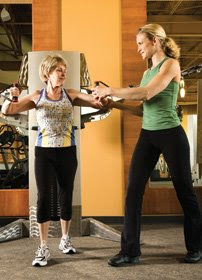 HealthDay News, by Ed Edelson (Apr. 21, 2008) — The first signs that men are at higher risk of heart disease than women appear during the adolescent years, according a new study that tracked boys and girls through their teens.
HealthDay News, by Ed Edelson (Apr. 21, 2008) — The first signs that men are at higher risk of heart disease than women appear during the adolescent years, according a new study that tracked boys and girls through their teens.This is not what we would have predicted," said Dr. Antoinette Moran, chief of pediatric endocrinology and diabetes at the University of Minnesota Children's Hospital, and lead author of the report in the April 22 issue of Circulation. "Because boys lose fat and gain muscle in adolescence, while girls add body fat.
At the start, 11-year-old boys and girls were similar in body composition, blood pressure and blood levels of lipids (fats). As expected, the percentage of body fat decreased in the boys and increased in the girls over the adolescent years.
Yet the study of the 507 Minneapolis school children found that between the ages of 11 and 19, levels of triglycerides, a type of blood fat associated with cardiovascular disease, increased in the boys and dropped in the girls. Levels of HDL cholesterol, the "good" kind that helps keep arteries clear, went down in boys but rose in girls.
Blood pressure increased in both, but significantly more in boys. And insulin resistance, a marker of cardiovascular risk, which was lower in boys at age 11, rose until the 19-year-old men were more resistant than the women.
But excess weight is of major importance in both sexes, Moran said. "Being overweight or obese can cancel out these relationships and cause increased cardiovascular risk for males and females," she said. "Any protection that the young women had was wiped out by obesity.
A recent study found that more than a third of children and adolescents in the United States are overweight or obese.
The study points toward the importance of hormonal factors in cardiovascular disease risk, Moran explained. "We knew that women had extra protection from cardiovascular disease, and we knew it disappeared after menopause," she said. "This adds further weight to the role of hormones by looking at the other end of the age spectrum.
One possible lesson of the study is that it is never too early to start protective measures against heart disease, said Dr. Stephen R. Daniels, chairman of the department of pediatrics at the University of Colorado.
Studies have used autopsies of young people who died in accidents to show that by the late teens, the kind of lesions we know cause heart attacks and strokes are in the process of developing," Daniels said. "So, in some ways, our best opportunity to prevent heart disease is to look at children and adolescents and start the preventive process early.
Fighting obesity in the years before adulthood is essential, he said. "Some changes that occur may be due to what is built into the difference between the sexes," he said. "But if you add overweight and obesity, you can increase risk through that mechanism.
More information
Facts about childhood obesity are available from the U.S. Surgeon General.
Source: Antoinette Moran, M.D., chief, pediatric endocrinology and diabetes, University of Minnesota Children's Hospital, Milwaukee; Stephen R. Daniels, M.D., chairman, pediatrics, University of Colorado, Denver; April 22, 2008, Circulation


